Related Research Articles

A rogueplanet, also termed a free-floating planet (FFP) or an isolated planetary-mass object (iPMO), is an interstellar object of planetary mass which is not gravitationally bound to any star or brown dwarf.

2M1207, 2M1207A or 2MASS J12073346–3932539 is a brown dwarf located in the constellation Centaurus; a companion object, 2M1207b, may be the first extrasolar planetary-mass companion to be directly imaged, and is the first discovered orbiting a brown dwarf.

GQ Lupi b, or GQ Lupi B, is a possible extrasolar planet, brown dwarf or sub-brown dwarf orbiting the star GQ Lupi. Its discovery was announced in April 2005. Along with 2M1207b, this was one of the first extrasolar planet candidates to be directly imaged. The image was made with the European Southern Observatory's VLT telescope at the Paranal Observatory, Chile on June 25, 2004.
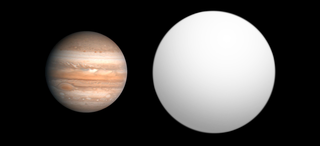
2M1207b is a planetary-mass object orbiting the brown dwarf 2M1207, in the constellation Centaurus, approximately 170 light-years from Earth. It is one of the first candidate exoplanets to be directly observed. It was discovered in April 2004 by the Very Large Telescope (VLT) at the Paranal Observatory in Chile by a team from the European Southern Observatory led by Gaël Chauvin. It is believed to be from 5 to 6 times the mass of Jupiter and may orbit 2M1207 at a distance roughly as far from the brown dwarf as Pluto is from the Sun.
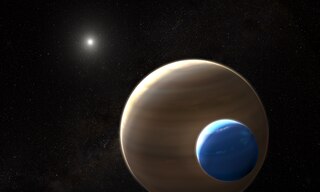
An exomoon or extrasolar moon is a natural satellite that orbits an exoplanet or other non-stellar extrasolar body.
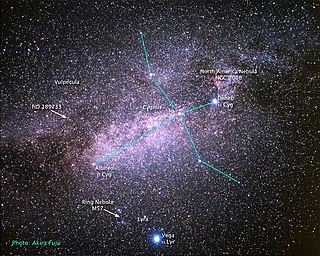
HD 189733, also catalogued as V452 Vulpeculae, is a binary star system 64.5 light-years away in the constellation of Vulpecula. The primary star is suspected to be an orange dwarf star, while the secondary star is a red dwarf star. Given that this system has the same visual magnitude as HD 209458, it promises much for the study of close transiting extrasolar planets. The star can be found with binoculars 0.3 degrees east of the Dumbbell Nebula (M27).

A sub-brown dwarf or planetary-mass brown dwarf is an astronomical object that formed in the same manner as stars and brown dwarfs but that has a planetary mass, therefore by definition below the limiting mass for thermonuclear fusion of deuterium . Some researchers call them rogue planets whereas others call them planetary-mass brown dwarfs. They are sometimes categorized as Y spectral class brown dwarfs.

Any planet is an extremely faint light source compared to its parent star. For example, a star like the Sun is about a billion times as bright as the reflected light from any of the planets orbiting it. In addition to the intrinsic difficulty of detecting such a faint light source, the light from the parent star causes a glare that washes it out. For those reasons, very few of the exoplanets reported as of January 2024 have been observed directly, with even fewer being resolved from their host star.

HR 8799 is a roughly 30 million-year-old main-sequence star located 133.3 light-years away from Earth in the constellation of Pegasus. It has roughly 1.5 times the Sun's mass and 4.9 times its luminosity. It is part of a system that also contains a debris disk and at least four massive planets. Those planets, along with Fomalhaut b, were the first exoplanets whose orbital motion was confirmed by direct imaging. The star is a Gamma Doradus variable: its luminosity changes because of non-radial pulsations of its surface. The star is also classified as a Lambda Boötis star, which means its surface layers are depleted in iron peak elements. It is the only known star which is simultaneously a Gamma Doradus variable, a Lambda Boötis type, and a Vega-like star.

2MASS J0441+2301 is a young quadruple system hosting a planetary-mass object, a red dwarf star and two brown dwarfs, approximately 470 light years away.

Strategic Explorations of Exoplanets and Disks with Subaru (SEEDS) is a multi-year survey that used the Subaru Telescope on Mauna Kea, Hawaii in an effort to directly image extrasolar planets and protoplanetary/debris disks around hundreds of nearby stars. SEEDS is a Japanese-led international project. It consists of some 120 researchers from a number of institutions in Japan, the U.S. and the EU. The survey's headquarters is at the National Astronomical Observatory of Japan (NAOJ) and led by Principal Investigator Motohide Tamura. The goals of the survey are to address the following key issues in the study of extrasolar planets and disks: the detection and census of exoplanets in the regions around solar-mass and massive stars; the evolution of protoplanetary disks and debris disks; and the link between exoplanets and circumstellar disks.

Kappa Andromedae b is a directly imaged substellar object and likely superjovian-mass planet orbiting Kappa Andromedae, a young B9IV star in the Andromeda constellation, about 170 light-years away. The companion's mass is roughly 13 times the mass of Jupiter. As early history on Kappa And b is filled with debate over whether it is an exoplanet or a brown dwarf, some scientists have broadly described it as a "super-Jupiter" object.
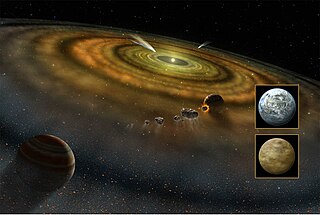
An exocomet, or extrasolar comet, is a comet outside the Solar System, which includes rogue comets and comets that orbit stars other than the Sun. The first exocomets were detected in 1987 around Beta Pictoris, a very young A-type main-sequence star. There are now a total of 27 stars around which exocomets have been observed or suspected.

The Next-Generation Transit Survey (NGTS) is a ground-based robotic search for exoplanets. The facility is located at Paranal Observatory in the Atacama desert in northern Chile, about 2 km from ESO's Very Large Telescope and 0.5 km from the VISTA Survey Telescope. Science operations began in early 2015. The astronomical survey is managed by a consortium of seven European universities and other academic institutions from Chile, Germany, Switzerland, and the United Kingdom. Prototypes of the array were tested in 2009 and 2010 on La Palma, and from 2012 to 2014 at Geneva Observatory.

A circumplanetary disk is a torus, pancake or ring-shaped accumulation of matter composed of gas, dust, planetesimals, asteroids or collision fragments in orbit around a planet. They are reservoirs of material out of which moons may form. Such a disk can manifest itself in various ways.
A Peter Pan disk is a circumstellar disk around a star or brown dwarf that appears to have retained enough gas to form a gas giant planet for much longer than the typically assumed gas dispersal timescale of approximately 5 million years. Several examples of such disks have been observed to orbit stars with spectral types of M or later. The presence of gas around these disks has generally been inferred from the total amount of radiation emitted from the disk at infrared wavelengths, and/or spectroscopic signatures of hydrogen accreting onto the star. To fit one specific definition of a Peter Pan disk, the source needs to have an infrared "color" of , an age of >20 Myr and spectroscopic evidence of accretion.

The Tucana-Horologium association (Tuc-Hor), or Tucana Horologium moving group, is a stellar association with an age of 45 ± 4 Myr and it is one of the largest stellar associations within 100 parsecs. The association has a similar size to the Beta Pictoris moving group (BPMG) and contains, like BPMG, more than 12 stars with spectral type B, A and F. The association is named after two southern constellations, the constellation Tucana and the constellation Horologium.

BD+60 1417b is a confirmed exoplanet discovered in the year 2021 using the imaging method. BD+60 1417b is the only known exoplanet in the system BD+60 1417, around 45 parsecs from Earth. BD+60 1417 is a young K0 star, while BD+60 1417 b has a late-L spectral type. The planet might be the first discovery of a directly imaged exoplanet found by a citizen scientist. Discovery of exoplanets involving amateurs are usually transiting exoplanets and are rarely discovered with other methods. Another example of a non-transiting exoplanet discovery by an amateur is the microlensing exoplanet Kojima-1Lb.
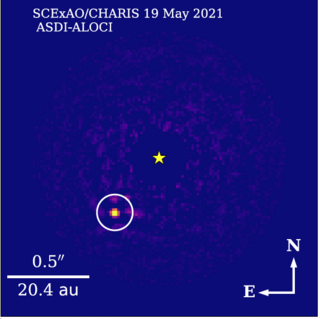
HIP 99770 b is a directly imaged superjovian extrasolar planet orbiting the dusty A-type star HIP 99770, detected with Gaia/Hipparcos precision astrometry and high-contrast imaging. HIP 99770 b is the first joint direct imaging + astrometric discovery of an extrasolar planet and the first planet discovered using precision astrometry from the Gaia mission.
References
- 1 2 3 4 Gaidos, E.; Hirano, T.; Kraus, A. L.; Kuzuhara, M.; Zhang, Z.; Lee, R. A.; Salama, M.; Berger, T. A.; Grunblatt, S. K.; Ansdell, M.; Liu, M. C.; Harakawa, H.; Hodapp, K. W.; Jacobson, S.; Konishi, M.; Kotani, T.; Kudo, T.; Kurokawa, T.; Nishikawa, J.; Omiya, M.; Serizawa, T.; Tamura, M.; Ueda, A.; Vievard, S. (2022). "Zodiacal exoplanets in time (ZEIT) XII: A directly imaged planetary-mass companion to a young Taurus M dwarf star". Monthly Notices of the Royal Astronomical Society. 512: 583–601. arXiv: 2110.08655 . doi:10.1093/mnras/stab3069.
- 1 2 3 Gaidos, Eric; Hirano, Teruyuki (2023-11-01). "CO, H2O, and CH4 in the dusty atmosphere of a ≲5 Myr-old exoplanet". Monthly Notices of the Royal Astronomical Society. 525 (4): 6303–6311. Bibcode:2023MNRAS.525.6303G. doi:10.1093/mnras/stad2664. ISSN 0035-8711.
- ↑ "Infant planet discovered by UH-led team using Maunakea telescopes". University of Hawai'i News. 2021-10-22. Retrieved 2021-11-22.
- ↑ "The Extrasolar Planet Encyclopaedia — 2M0437 b". Extrasolar Planets Encyclopaedia . Retrieved 2021-11-22.
- ↑ Carter, Jamie. "An Alien Planet Has Been Photographed: Youngest Planet Ever Found Joins 'Elite List' Say Scientists". Forbes. Retrieved 2021-11-22.
- ↑ "An 'Infant' Planet Could Shed Light on the Formation of the Solar System". interestingengineering.com. 2021-10-25. Retrieved 2021-11-22.
- ↑ "Rare Direct Image Of An Exoplanet Might Be The Youngest Ever Found". IFLScience. 25 October 2021. Retrieved 2021-11-22.